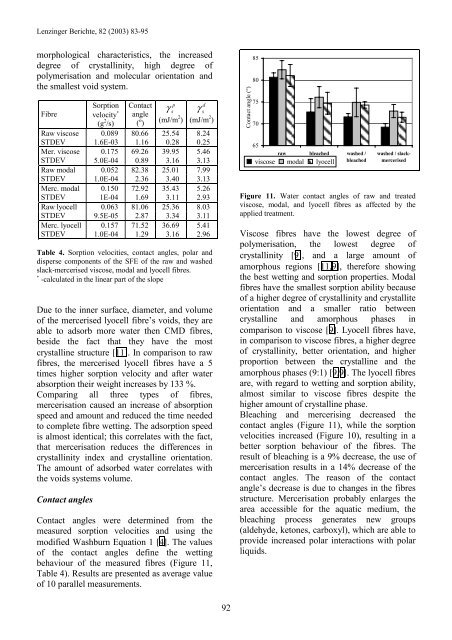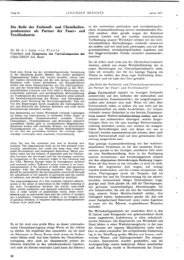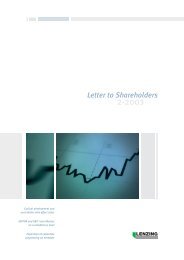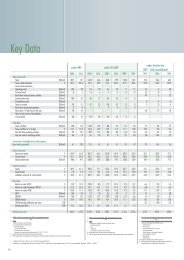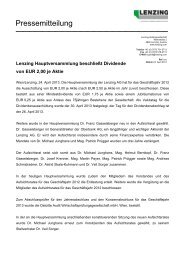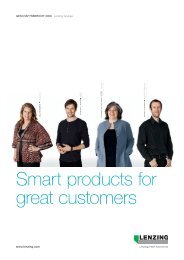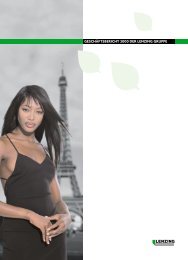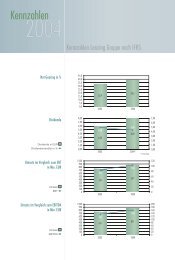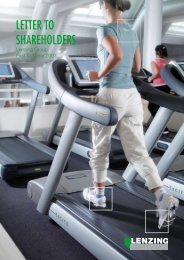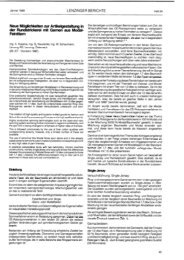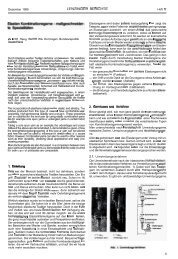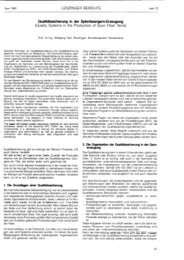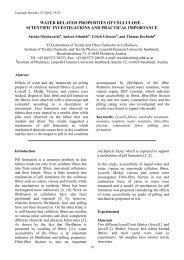Correlation of regenerated fibres morphology and surface ... - Lenzing
Correlation of regenerated fibres morphology and surface ... - Lenzing
Correlation of regenerated fibres morphology and surface ... - Lenzing
Create successful ePaper yourself
Turn your PDF publications into a flip-book with our unique Google optimized e-Paper software.
<strong>Lenzing</strong>er Berichte, 82 (2003) 83-95<br />
morphological characteristics, the increased<br />
degree <strong>of</strong> crystallinity, high degree <strong>of</strong><br />
polymerisation <strong>and</strong> molecular orientation <strong>and</strong><br />
the smallest void system.<br />
Fibre<br />
Sorption<br />
velocity ∗<br />
(g 2 /s)<br />
Contact<br />
angle<br />
( o )<br />
p<br />
γ s<br />
(mJ/m 2 )<br />
d<br />
γ s<br />
(mJ/m 2 )<br />
Raw viscose 0.089 80.66 25.54 8.24<br />
STDEV 1.6E-03 1.16 0.28 0.25<br />
Mer. viscose 0.175 69.26 39.95 5.46<br />
STDEV 5.0E-04 0.89 3.16 3.13<br />
Raw modal 0.052 82.38 25.01 7.99<br />
STDEV 1.0E-04 2.36 3.40 3.13<br />
Merc. modal 0.150 72.92 35.43 5.26<br />
STDEV 1E-04 1.69 3.11 2.93<br />
Raw lyocell 0.063 81.06 25.36 8.03<br />
STDEV 9.5E-05 2.87 3.34 3.11<br />
Merc. lyocell 0.157 71.52 36.69 5.41<br />
STDEV 1.0E-04 1.29 3.16 2.96<br />
Table 4. Sorption velocities, contact angles, polar <strong>and</strong><br />
disperse components <strong>of</strong> the SFE <strong>of</strong> the raw <strong>and</strong> washed<br />
slack-mercerised viscose, modal <strong>and</strong> lyocell <strong>fibres</strong>.<br />
∗ -calculated in the linear part <strong>of</strong> the slope<br />
Due to the inner <strong>surface</strong>, diameter, <strong>and</strong> volume<br />
<strong>of</strong> the mercerised lyocell fibre’s voids, they are<br />
able to adsorb more water then CMD <strong>fibres</strong>,<br />
beside the fact that they have the most<br />
crystalline structure [11]. In comparison to raw<br />
<strong>fibres</strong>, the mercerised lyocell <strong>fibres</strong> have a 5<br />
times higher sorption velocity <strong>and</strong> after water<br />
absorption their weight increases by 133 %.<br />
Comparing all three types <strong>of</strong> <strong>fibres</strong>,<br />
mercerisation caused an increase <strong>of</strong> absorption<br />
speed <strong>and</strong> amount <strong>and</strong> reduced the time needed<br />
to complete fibre wetting. The adsorption speed<br />
is almost identical; this correlates with the fact,<br />
that mercerisation reduces the differences in<br />
crystallinity index <strong>and</strong> crystalline orientation.<br />
The amount <strong>of</strong> adsorbed water correlates with<br />
the voids systems volume.<br />
Contact angles<br />
Contact angles were determined from the<br />
measured sorption velocities <strong>and</strong> using the<br />
modified Washburn Equation 1 [4]. The values<br />
<strong>of</strong> the contact angles define the wetting<br />
behaviour <strong>of</strong> the measured <strong>fibres</strong> (Figure 11,<br />
Table 4). Results are presented as average value<br />
<strong>of</strong> 10 parallel measurements.<br />
92<br />
Contact angle (°)<br />
85<br />
80<br />
75<br />
70<br />
65<br />
raw bleached washed /<br />
bleached<br />
viscose modal lyocell<br />
washed / slackmercerised<br />
Figure 11. Water contact angles <strong>of</strong> raw <strong>and</strong> treated<br />
viscose, modal, <strong>and</strong> lyocell <strong>fibres</strong> as affected by the<br />
applied treatment.<br />
Viscose <strong>fibres</strong> have the lowest degree <strong>of</strong><br />
polymerisation, the lowest degree <strong>of</strong><br />
crystallinity [9], <strong>and</strong> a large amount <strong>of</strong><br />
amorphous regions [11,9], therefore showing<br />
the best wetting <strong>and</strong> sorption properties. Modal<br />
<strong>fibres</strong> have the smallest sorption ability because<br />
<strong>of</strong> a higher degree <strong>of</strong> crystallinity <strong>and</strong> crystallite<br />
orientation <strong>and</strong> a smaller ratio between<br />
crystalline <strong>and</strong> amorphous phases in<br />
comparison to viscose [9]. Lyocell <strong>fibres</strong> have,<br />
in comparison to viscose <strong>fibres</strong>, a higher degree<br />
<strong>of</strong> crystallinity, better orientation, <strong>and</strong> higher<br />
proportion between the crystalline <strong>and</strong> the<br />
amorphous phases (9:1) [9,9]. The lyocell <strong>fibres</strong><br />
are, with regard to wetting <strong>and</strong> sorption ability,<br />
almost similar to viscose <strong>fibres</strong> despite the<br />
higher amount <strong>of</strong> crystalline phase.<br />
Bleaching <strong>and</strong> mercerising decreased the<br />
contact angles (Figure 11), while the sorption<br />
velocities increased (Figure 10), resulting in a<br />
better sorption behaviour <strong>of</strong> the <strong>fibres</strong>. The<br />
result <strong>of</strong> bleaching is a 9% decrease, the use <strong>of</strong><br />
mercerisation results in a 14% decrease <strong>of</strong> the<br />
contact angles. The reason <strong>of</strong> the contact<br />
angle’s decrease is due to changes in the <strong>fibres</strong><br />
structure. Mercerisation probably enlarges the<br />
area accessible for the aquatic medium, the<br />
bleaching process generates new groups<br />
(aldehyde, ketones, carboxyl), which are able to<br />
provide increased polar interactions with polar<br />
liquids.


